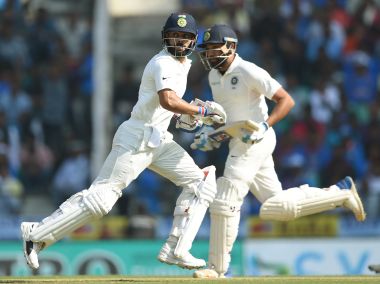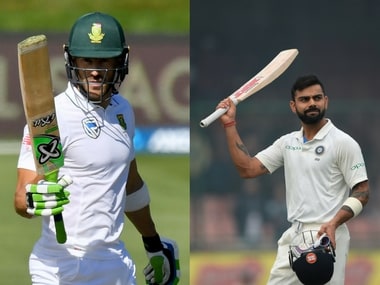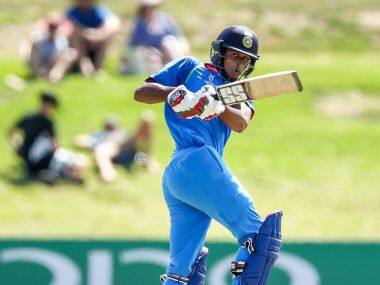India vs South Africa: Declining intensity, dropped catches could well prove to be visitors' Achilles heel
Despite producing moments of brilliance, dropped chances as well as declining on-field intensity to lower-order batsman could hurt India's chances of beating South Africa at their own backyard.
Rohit Sankar, Jan,15 2018
| Rank | Team | Points | Rating |
|---|---|---|---|
| 1 | India | 4969 | 124 |
| 2 | South Africa | 3888 | 111 |
| 3 | Australia | 4174 | 104 |
| 4 | New Zealand | 3489 | 100 |
| 5 | England | 4829 | 99 |
| 6 | Sri Lanka | 4058 | 94 |
| Rank | Team | Points | Rating |
|---|---|---|---|
| 1 | South Africa | 6386 | 120 |
| 2 | India | 6680 | 119 |
| 3 | Australia | 5948 | 114 |
| 4 | England | 6156 | 114 |
| 5 | New Zealand | 6257 | 114 |
| 6 | Pakistan | 4747 | 97 |
| Rank | Team | Points | Rating |
|---|---|---|---|
| 1 | New Zealand | 2262 | 126 |
| 2 | Pakistan | 2843 | 124 |
| 3 | India | 3385 | 121 |
| 4 | England | 2029 | 119 |
| 5 | West Indies | 2538 | 115 |
| 6 | South Africa | 2238 | 112 |





India vs South Africa, January 2018. Second Test at Centurion. Day 2.
Over 103.3 — Ravichandran Ashwin to Kagiso Rabada
The wily off-spinner unfurls one from the top drawer, squaring up Rabada and extracting enough turn to eke out an edge. The ball carries fairly easily to Virat Kohli at first slip but the Indian skipper — the furious celebration of Rabada's catch in the first Test now a distant memory — drops a sitter.
Over 103.4 — Ashwin to Rabada.
Ashwin shortens his length but is greeted by Rabada stepping down the track and swishing hard. Another edge results, but this time it goes skyward and towards Hardik Pandya at point who positions himself to welcome the easiest catch of his career when Mohammed Shami rushes across from short third man, blinds Pandya and the all-rounder drops the catch.
Hardik Pandya and Mohammed Shami make a mess of a chance after a leading edge off Kagiso Rabada's bat on Day 2. AP
***
Seven overs later, Rabada pulls Ishant Sharma to deep square leg but does not quite middle it as well as he would have liked. Pandya, furious from the earlier drop and revenge boiling in his blood, rushes in and grabs it with both hands before throwing the ball onto the surface seething with anger.
It was an outrageous catch from Pandya whose ground fielding and catching has been exemplary right through the series.
It has been the story of India's fielding for quite some time now. They drop sitters (especially in the cordon) and then pull off blinders or throw down stumps with amazing athleticism, not to mention the exaggerated celebration, particularly the disdain shown to the poor red ball after pulling off something out of the blue.
Take this into consideration. South Africa's first innings total in this Test would have been 248 if India had taken all the chances that had come their way in the field. A lot has been written about the amazing turnaround the visitors made to reduce South Africa from 245/3 to 335 all out. But the fact is the hosts wouldn't even have made it to 250 had India pulled their act together in the field.
Hashim Amla, batting on 11, was reprieved by that man Pandya when he shelled a tough chance off Ravichandran Ashwin at short mid-on. Pandya was outstanding in the field later on and the two run-outs late in the day overshadowed his costly drop (Amla went on to make 82).
India might still have gotten away with it had Parthiv Patel not put down the No 3 batsman off an edge down leg-side when on 30. Ishant Sharma's wayward lines tempted Amla and the South African nonchalantly flicked off his hips only for the edge to carry to Patel behind the stumps. The Indian keeper, though, missed out.
Rabada was dropped twice on the second day before Patel — ever so close to transcending into Kamran Akmal territory — once again hogged the limelight by missing a catch gifted by Faf du Plessis when on 54. He added just nine more to his score but the five dropped chances (Amla on 2, Rabada on 2, du Plessis on 1) together accounted for 87 runs, which, if cut out from South Africa's 335, comes down to 248.
This hasn't been a solitary incident on this tour. In the first Test at Cape Town — where India's catching was admittedly a whole lot better than in their home season — Shikhar Dhawan shelled Keshav Maharaj's catch in the first innings when the spinner was on zilch.
He went on to score 35 runs, pretty vital given that the game was a low-scoring thriller. Without Maharaj's contribution, South Africa would have made just 251 in the first innings and India might well have been chasing something around the 180 mark in the final attempt.
CricViz estimates that since 2010, India have dropped an average of 2.83 catches every Test. This Test alone the number has gone up to an alarming five (remember South Africa have only batted once so far).
In the recently concluded lengthy home season, India were equally woeful with their catching, but more often than not, got away with the conditions aligned in their favour. The downright mediocrity of the opponents also played into their hands.
The swagger of the Indian batsmen on home tracks and the dominance of spinners masked their shoddy work in catching during the Tests in India, but after five days of Test cricket in South Africa, it is already proving to be their nemesis.
What is bizarre is that amidst all the sitters India have dropped here so far, there have been some spectacular catches and run-outs from the very same fielders. Following this trail closely, you notice that there is a certain pattern in India's approach in the field in an innings.
When Bhuvneshwar Kumar ran in and scythed through South Africa's top order in the first Test, you could barely hear the commentary above the cacophony in the slip cordon. Kohli was constantly urging his teammates on with Saha and the others joining hands.
It witnessed a freefall as de Villiers counter-attacked and du Plessis resisted anything thrown at him, with Kohli going from disturbing chatterbox to watchful saint in the cordon. At 142/5, they virtually had South Africa on the mat on Day 1 of an away Test, but failed to make it count.
By the time Maharaj was dropped by Dhawan, South Africa had resurrected their innings a touch but things hadn't completely gone out of hand for India. It would be safe to say that their dropping intensity — a word that is often over-emphasized by the skipper in the press conferences — led to Maharaj's drop.
Roll forward to this Test, and once again three out of the five dropped chances came after India had removed the bulk of South Africa's top-order. There seems to be a clear lack of vigour and oomph — a drastic deviation from their noisy self — in the field once they get to the lower half of the batting order, except, of course, when one catch sticks and you throw the ball into grass with the vengeance of a break-up.
At Cape Town they had removed the top five of South Africa's batting line-up with the score on 142. But the hosts eventually doubled the total. Here, they had South Africa at 251/6 — forget Amla's missed chances — with the cream of their batting back in the hut, but yet again watched as South Africa put on 335.
Yes, it was brilliance in the field that saw them reduce the Proteas to 251/6 from 245/3. But what unfolded next was a dreadful drop in intensity and three dropped chances on Day 2. The tendency to doze off after a vigilant start seem to be hurting the visitors to no end, but the worrying factor here is that they seem to be blissfully unaware of it.
The old adage goes along the lines of 'catches win matches’, but this Indian team is used to dropping them and getting away scot-free, the hegemony at home camouflaging an obvious weakness. The Australian as well as the drab Sri Lankan series' at home later saw India drop countless catches.
“When catches are dropped off your bowling, you feel angry,” Shami had conceded during the Delhi Test — in which India dropped an appalling four catches - against Sri Lanka a month back. “But as a unit, we stay together for almost the entire year while playing. So it’s better to ignore such things as it’ll be better from the team’s point of view.”
It is hard to ignore the irony in Shami's words. 'Ignoring' the issues with dropped chances does little good from a team’s point of view. You are constantly pestered to move on once something disastrous strikes. But when it can be easily rectified, why would India remain in denial? 'Ignoring' something which has been a constant concern is probably not the right step forward particularly when the odds are stacked up against you in alien conditions.
Dropped chances are costing India dear and they should probably take the proverb more seriously and work on their catching. It would be disastrous to leave South Africa without a win when eliminating something as minor as butterfingers — “ignored” until now — might overturn their fortunes.
Published Date:Jan 15, 2018
| Updated Date: Jan 15, 2018
Also See
India vs South Africa 2nd Test selection: If four bowlers can do the job, Virat Kohli shouldn't hesitate to drop Hardik Pandya
India vs South Africa, stats preview: From threat posed by hosts' pacers to visitors' dismal record in Rainbow Nation
India vs South Africa: Struggling visitors need Virat Kohli, Hardik Pandya to defy Proteas on Day 3